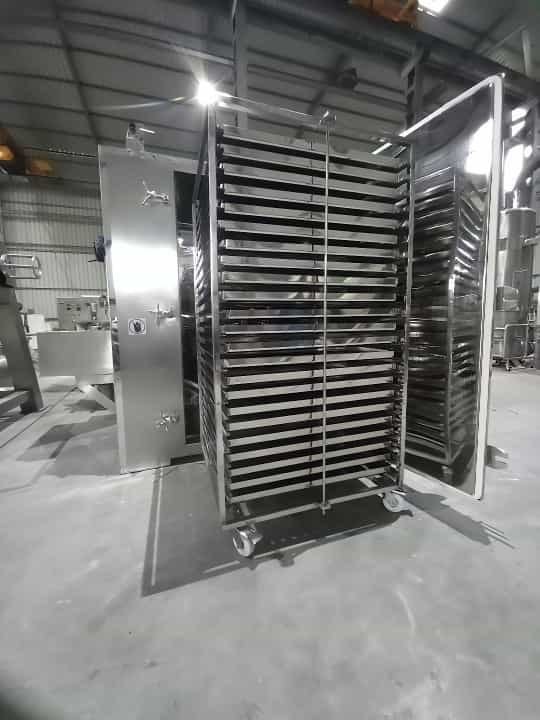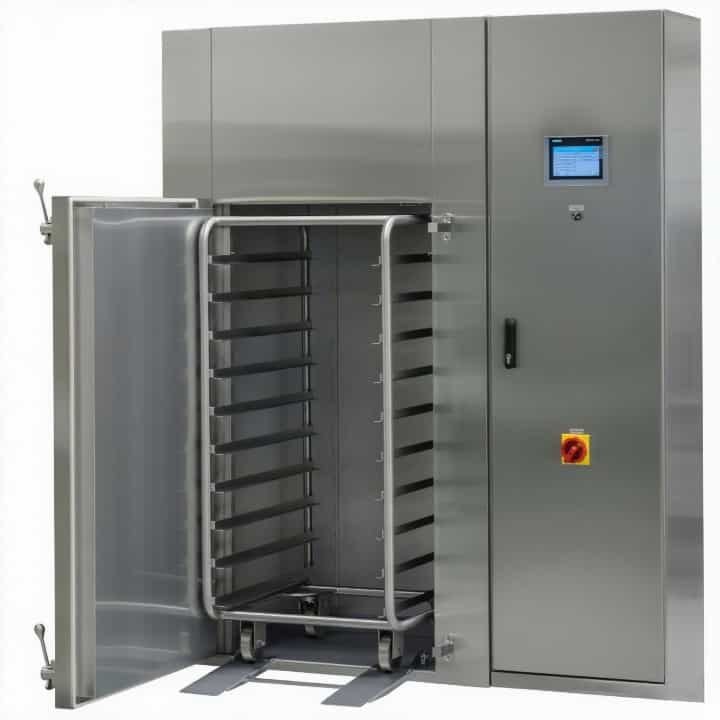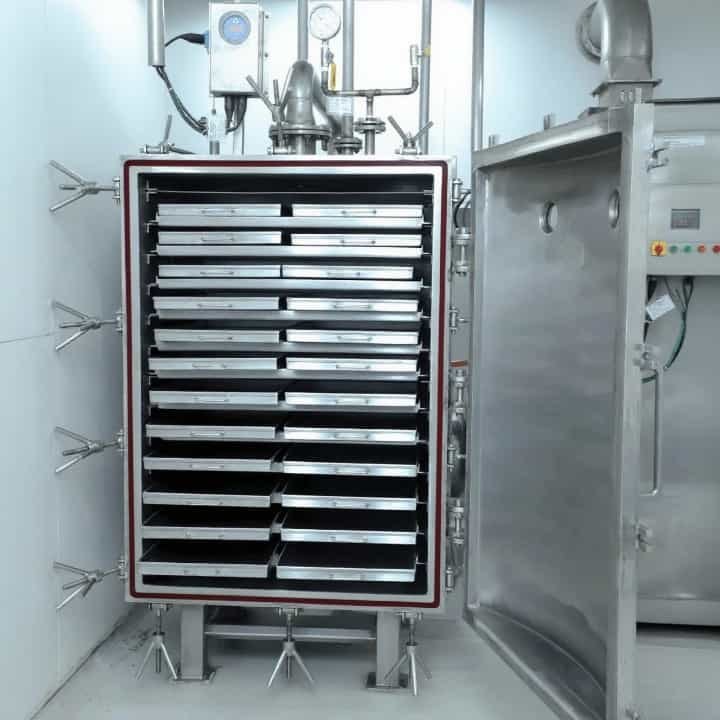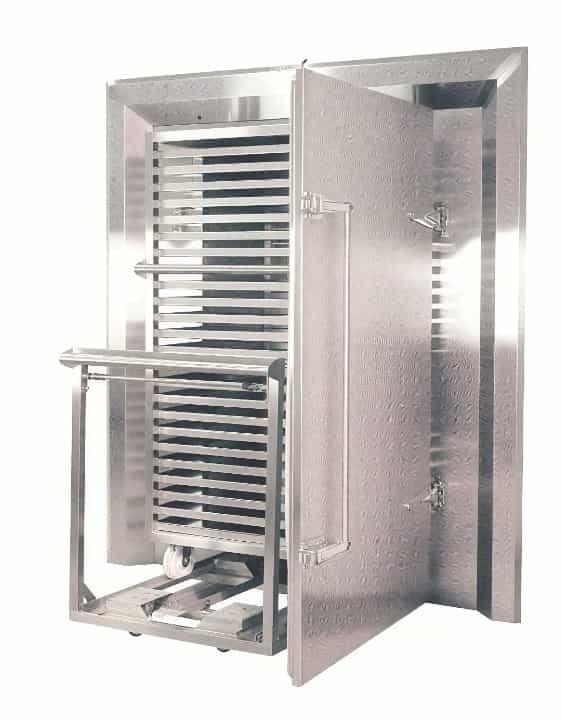A tray dryer is a closed, insulated box. It is made for drying different things in batches. It uses heated air and trays. Many industries use tray dryers. These include pharmaceuticals, food processing, and chemicals. They help dry things evenly and keep products good. Tray dryers blow hot air over items on trays. This is called forced convection. This makes them very useful in factories. They have features like exact temperature control. They also stop contamination and save energy. These features make them popular.
Tray dryers can dry powders, granules, herbs, and other solids.
More people want tray dryers, so the global market is growing.
Key Takeaways
Tray dryers use hot air and trays to dry things gently and evenly. This makes them great for powders, herbs, and items that are sensitive to heat. Good airflow helps dry things faster and more evenly. Spreading materials thin on trays also helps improve quality. Loading the dryer the right way is important. Controlling the temperature keeps things safe. Cleaning the dryer often helps it work well and last longer. Tray dryers are used in many industries like medicine, food, and chemicals. They help keep products good while drying. Vacuum tray dryers dry things faster at lower temperatures. This makes them good for delicate items that cannot take much heat.
What Is the Working Principle of a Tray Dryer?
A tray dryer works by circulating hot air over trays loaded with wet materials, evaporating moisture through a controlled heating process. The trays are stacked in a chamber where airflow and temperature are regulated to achieve uniform drying.
Tray Drying Explained
Tray drying is a simple way to dry wet solids. First, workers put wet materials on trays. These trays go inside a big, insulated chamber. The chamber keeps heat in and blocks outside air.
Workers slide trays into the chamber.
The system heats air with radiator coils or electric heaters.
Blower fans move hot air through the chamber at 2 to 5 meters per second.
The hot air blows over the wet solids. This lowers vapor pressure and makes the air layer around each piece thinner.
Water starts to evaporate from the surface. Moisture inside the product moves out by capillary action.
Most air, about 80-90%, is used again. Only a little fresh air comes in to keep drying efficient.
Moist air leaves the chamber through an outlet. The system dries until the product has the right moisture level.
A control panel lets workers set and watch temperature and other settings.
Note: Tray drying works best for small batches and heat-sensitive products. Workers can turn trays or change airflow to help dry things evenly.
Tray dryers use a batch process. Workers load and unload trays by hand. Drying takes a long time, but it gives good control over quality. Tray drying is simple and saves money, but it can take longer and sometimes dries unevenly.
Convection and Air Circulation
Convection is important in a tray dryer. The system uses hot air or steam to heat the wet material. Hot air moves over the surface and makes water evaporate. The airflow carries away the moisture. This helps dry things fast and evenly.
Most heat moves from the air to the product surface by convection.
Inside the product, heat moves by conduction to remove deep moisture.
Good airflow design, like changing air direction, helps dry all trays evenly.
Airflow patterns in the chamber can change how evenly things dry. Sometimes, air moves faster over some trays. This can make some trays drier than others. Studies show that moving trays or changing airflow can fix this. Even airflow and temperature are needed for good results.
Tip: Workers should check airflow and turn trays if needed. This helps every tray get the same hot air, so drying is even.
Drying in a tray dryer uses both heat and mass transfer. Moisture moves from inside the product to the surface, then into the air. Air speed, temperature, and humidity change how fast and even things dry. Scientists use models to study these things and make dryers better.
Tray dryers are still popular because they dry gently and protect quality. Newer methods may be faster or use less energy, but tray dryers are still a good choice for many industries.
What Is the Construction of a Tray Dryer?
A tray dryer is constructed with a series of trays placed inside an insulated chamber where hot air circulates to remove moisture from materials. This design ensures even drying and efficient heat utilization.

Trays and Chamber Design
A tray dryer has a big box with many trays on shelves. Each tray has space above and below for air to move. The trays are usually made of stainless steel. This metal does not rust or get damaged by heat. Some trays have small holes or mesh at the bottom. These help air pass through for better drying. Workers put the product in thin layers on each tray. This helps everything dry the same way.
Tip: Spreading things thin on trays makes drying faster and more even.
The chamber is closed and has insulation. This keeps heat inside and blocks outside air. The chamber can hold many trays, so it works well for batches.
Heating and Airflow System
Tray dryers use indirect heating. The air gets hot from electric coils, steam, or hot oil. Strong fans move the hot air through the chamber. These fans blow air over and around every tray. Vertical air distributors keep the air speed the same for all trays. This helps each tray get the same heat. There are vents to let out wet air and keep drying steady.
A digital control panel lets workers set heat and time. Safety features like overload protection and emergency stops keep things safe.
Insulation and Materials
Tray dryers are made with strong, clean materials. Trays and parts that touch the product use stainless steel (AISI 304 or 316). This keeps the dryer safe and easy to wash. The chamber walls have thick insulation, like glass wool or foam. This keeps heat inside and saves energy. Doors have silicone gaskets to seal tight and stop heat from leaking.
Part | Material/Feature |
|---|---|
Trays | Stainless Steel AISI 304/316 |
Chamber Interior | Stainless Steel, easy to clean |
Insulation | |
Door Seal | Silicone gasket |
Control Panel | Digital temperature and timer controls |
Note: Checking and fixing insulation often helps save energy in the tray dryer.
How to Use Tray Dryer
Tray dryers work best when workers follow each step. Good habits help keep products safe and dry them well. This part shows how to use tray dryer equipment for better quality and safety.

Loading and Unloading
Workers need to load and unload trays carefully. How they put things on trays changes how well things dry. Using shelves that are fully lined up helps stop products from falling. It also lowers the number of bad products. The table below shows how many products get rejected with two ways of loading:
Loading Method | Shelf 1 | Shelf 2 | Shelf 3 | Shelf 4 |
|---|---|---|---|---|
Indexing During Loading | 13.2% | 15.5% | 18.7% | 20.0% |
Fully Indexed Shelves | 0.2% | 0.5% | 0.7% | 0.9% |

Workers can use throw-away trays with special covers. These covers let water out but keep things clean. They also stop things from blowing out when loading or unloading. Using trays one time means no washing is needed. This saves time and keeps things clean. Some trays, like GORE LYOGUARD, have a tiny-holed cover. This keeps the product in and stops spills. It also helps fill trays faster and lets heat move better.
Tip: Always spread the material in a thin, even layer on each tray. This helps air reach all parts and dries the product evenly.
Clean ways of working during filling keep germs low. Workers should check the temperature inside the dryer. They should know how things change with different machines. This stops problems like products falling apart from quick temperature changes.
Setting Temperature and Time
Workers must pick the right heat and drying time for each thing. Here are the basic steps:
Heat the tray dryer to the right temperature before loading.
Put the material on trays and spread it out.
Set the drying time for the amount and type of material.
Change the temperature if needed to keep drying steady.
Check how wet the product is and change things if needed.
Note: The best heat and drying time depend on what you are drying. Workers must check and change settings to get the best results.
Workers should not use the same numbers for every product. Each thing dries at its own speed. Checking often helps stop over-drying or leaving things too wet.
Safety and Maintenance
Safety is most important when using a tray dryer. Workers must follow rules to stop accidents and keep the machine working. Here are the main safety steps:
Let out steam, water, and air before opening the dryer.
Close steam and water pipes before going inside.
Have someone watch the entrance when working inside.
Check lifting tools before use and keep people away from lifted parts.
Use only the lift points the maker says to use.
Lift evenly if using two hooks.
Do not trust air or oil lifts to hold things up; use blocks.
Use stops when taking off heavy parts.
Cover hot pipes to stop burns.
Do not weld cast iron dryers; follow maker’s rules.
Check dryer cylinders every 2-3 years for damage.
Fix leaks or loose plates right away.
Check the outside for damage every year.
Fix leaks between the dryer head and shell right away.
Check after big jams or damage.
Train all workers on safe use and give more training often.
Put up barriers, walkways, and warning signs.
Have a trained person watch safety and repairs.
Check and change old ropes and guards.
Cleaning and fixing the tray dryer often keeps it working well. Workers should:
Wash trays with warm water and safe cleaners.
Clean fans and ducts; change filters if needed.
Do not use strong chemicals that can hurt parts.
Follow a cleaning and repair plan.
Check all parts for damage or wear.
Check controls for heat, air, and wetness.
Turn trays and do not overload to fix uneven drying.
Check heaters if the dryer does not get hot enough.
Tip: Use tough materials and good welds to stop wear and avoid breakdowns. Change seals and gaskets often to keep the dryer sealed tight.
Workers who know how to use and clean tray dryer equipment will get better results and make the machine last longer.
What Are the Applications of a Tray Dryer?
Tray dryers are primarily used for drying materials in a controlled environment to ensure uniform moisture removal. They are essential in pharmaceuticals, food processing, chemicals, and agricultural sectors.

Pharmaceuticals
Pharmaceutical companies use tray dryers a lot. They dry powders, granules, and herbs. Workers can change heat and airflow. This helps keep medicine safe and strong. Tray dryers work in batches. This is good for products that need to stay clean and separate. People dry things like powders, herbal extracts, and granules. Changing time and heat helps keep the right amount of water. It also stops damage to ingredients that are easy to ruin. Tray dryers help keep the size, purity, and strength of medicines. These things are important for safe medicine.
Drying powders, granules, and herbs
Batch processing for strict quality control
Protecting sensitive pharmaceutical products
Food Processing
Food companies use tray dryers a lot. They dry fruits, vegetables, herbs, spices, grains, and nuts. Hot air takes out water and keeps taste, color, and nutrients. Many companies use tray dryers for dairy, coffee, tea, and meals that are ready to eat. Vacuum tray dryers are good for foods that cannot take much heat. They help keep taste and nutrition. The table below shows how tray drying and freeze drying are different:
Aspect | Tray Drying (Air Drying) | Freeze Drying |
|---|---|---|
Nutritional Retention | Lower | Higher |
Sensory Qualities | Lower | Higher |
Shelf Life | Good | Excellent |
Note: Tray dryers help food last longer and stay safe. Some nutrients can be lost when drying.
Chemicals and Granulation
Chemical companies use tray dryers to dry powders and granules. They also dry chemical additives. Hot air dries things on trays. The inside is made of stainless steel and has digital controls. This keeps things safe and good quality. Tray dryers dry wet granules, crude drugs, and herbal extracts. They are good for things that need gentle drying. Some companies use tray dryers with granulation machines. This helps make products faster and keeps size and hardness the same.
Other Uses
Tray dryers are used in the textile industry too. They dry fabrics, yarns, and dyes. They take out water without hurting the fibers. Labs use tray dryers for research and tests. They can dry sticky things, pigments, and ceramics. Tray dryers are useful for many jobs in different industries.
What Are the Different Types and Their Pros and Cons?
There are various types of strategies, each with distinct advantages and disadvantages. Understanding these can help in making informed decisions.

Vacuum Tray Dryer
A vacuum tray dryer is a special kind of tray dryer. It works by making the air pressure inside the chamber lower. This lets water boil at a cooler temperature. The dryer can take out water without using a lot of heat. This helps keep medicines and some foods safe from damage. The product sits on trays in a closed chamber. The system heats the trays slowly and gently. The vacuum helps water leave the product faster.
The table below shows how a vacuum tray dryer and a regular tray dryer are different:
Feature | Vacuum Tray Dryer | Conventional Tray Dryer |
|---|---|---|
Operating Pressure | Reduced pressure (vacuum) | Atmospheric pressure |
Operating Temperature | Lower temperatures due to reduced boiling point | Higher temperatures |
Drying Speed | Faster drying due to enhanced evaporation under vacuum | Slower drying relying on convection and atmospheric conditions |
Product Quality | Better quality; prevents thermal degradation, ideal for heat-sensitive materials | Risk of thermal damage to heat-sensitive products |
Energy Consumption | More energy-efficient due to lower temperature and faster drying | Higher energy use due to longer drying times and higher temperatures |
Suitable Materials | Heat-sensitive pharmaceuticals, chemicals, food products | Materials that tolerate heat, powders, granules |
Drying Uniformity | More uniform drying due to even tray distribution | Uniform but less controlled drying |
Note: A vacuum tray dryer is best for things that need gentle drying and cannot take high heat.
Advantages
Tray dryers have many good points for factories:
Batch processing lets workers dry different things at different times.
They can handle materials with little loss when loading or unloading.
They use less energy, which saves money for small batches.
There are many sizes and prices, so companies can pick what they need.
They dry powders, granules, and sticky things well.
The design makes them easy to use and clean.
Drying is even across trays, so quality stays high.
They do not take up much space in a factory.
Workers can control the temperature to protect sensitive products.
Disadvantages
Tray dryers also have some problems:
Loading and unloading by hand needs more workers, so labor costs go up.
Drying takes a long time, sometimes up to 42 hours for one batch.
They are not good for some things, like products that break down or react with air.
Sometimes, drying is not even, especially on the bottom trays.
The machines can cost a lot at first and use a lot of energy.
If cleaning is not done well, food and medicine can get dirty.
Some tray dryers do not have trays with holes, so heat and air may not reach all parts.
Tip: Cleaning often and loading trays with care can help fix many of these problems.
Tray dryers are important for companies that need careful drying. People should think about what they are drying and how much they need to make. They should also look at safety features before picking a tray dryer. Workers can make the dryer work better by cleaning it often. They should load trays the right way and check the machine often. Drying can take a long time, but it helps keep products good. If companies use the right steps, their products will be better. Their tray dryers will also last longer.
FAQ
What materials can a tray dryer handle?
A tray dryer can dry many things like powders, granules, herbs, fruits, and vegetables. It can also dry sticky products. Many companies use it for things that need gentle drying. It helps keep products safe from getting dirty.
How does a tray dryer keep products safe?
Tray dryers have trays made of stainless steel and a sealed box. This keeps out dust and germs. Workers can set the heat and how air moves. This helps protect products that are easy to damage.
How long does drying take in a tray dryer?
How long drying takes depends on what you put in and how wet it is. Most batches need a few hours to dry. Some things may take up to 42 hours to finish drying.
What is the main difference between a tray dryer and a vacuum tray dryer?
Tray Dryer | Vacuum Tray Dryer |
|---|---|
Uses hot air | Uses low pressure (vacuum) |
Higher temperature | Lower temperature |
Slower for some items | Faster for sensitive items |
Note: Vacuum tray dryers are better for things that cannot take much heat.

